Florence - Galileo landmarks of memory
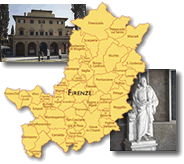
In Florence, ever since Galileo’s death, whole generations of scholars and experts, from his direct followers until today, have lived (even materially) off the historical and intellectual heritage left us by this scientist who was one of the most ingenious and brilliant personalities of all time. Celebrative testimonies dot the entire city.
[Given the limitations on traffic in the historical centre , we advise you undertake the first legs of the proposed itinerary on foot]
Palazzo Viviani or "Casa dei cartelloni", which Vincenzo Viviani had built with pension money he received from Louis XIV of France, bears on its face scrollwork narrating the life the Galileo.
The Palazzo dei Cartelloni, which was the residence of Vincenzo Viviani, was the first public monument in Florence to render homage to Galileo Galilei. Viviani had fondly assisted the Pisan scientist from October 1639 until his death (1642). In the decades that followed, he spent enormous energies on the project for a monumental sepulchre to erect in honour of the Maestro, but he did not succeed in overcoming the resistance of church environments which considered it inopportune to celebrate the memory of a man condemned for "vehement suspicion of heresy". So it was that in 1690 Viviani commissioned his friend Giovan Battista Nelli with the realisation of the facade of his palazzo, courageously conceived as a monument to Galileo. In addition to two large cartouches with inscriptions exalting the discoveries of the Maestro, he had a bust mounted with bas reliefs on either side evoking several of the Pisan scientist’s discoveries. One alludes to the observation of the satellites of Jupiter, using the telescope, in order to determine the longitude at sea, while the other refers to Galileo defining the parabolic motion of projectiles. Only in 1737 was the monumental sepulchre in the Basilica of Santa Croce inaugurated, and the moral remains of Galileo and of his loyal follower Viviani, who had died more than thirty years before, were placed to rest there.
Today, Palazzo Viviani hosts the Studio Art Centers International (SACI) of Florence, and inside also has a small, lovely garden in the mock-classical style.
(Graziano Magrini)
One of the statues adorning the 19th-century façade of Florence’s Duomo, which you can reach from via dell'Amorino and via de' Conti, portrays Galileo with his telescope.
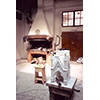
The Cathedral of Santa Maria del Fiore was founded in 1296 on the site of the early Christian basilica of Santa Reparata. Construction began from the facade, probably on a project by Florentine architect Arnolfo di Cambio, and lasted for approximately two centuries (the facade was completed, however, only at the end of the 19th century). Always considered a temple of art, as well as a place of worship, the Cathedral also preserves important evidence that refers to the world of science.
In 1475, mathematician Paolo dal Pozzo Toscanelli built a gnomon, the highest ever built in a church and the oldest that has come down to us, which makes it possible to check the moment of the Sun’s passage into the summer solstice. A bronze tablet, called bronzina, bearing the gnomonic hole was placed at the base of the cupola’s lantern. In the period between May and July, the sun’s rays filter through this hole and give rise to an image of the Sun about 90 metres below, on the floor of the Cappella della Croce, where the Renaissance solstice signs are found, along with the meridian altitude installed in 1755 by Jesuit Leonardo Ximenes.
The clock by Paolo Uccello on the counter facade ideally certifies the passage from the Sun’s motion to the mechanical reckoning of the passing of time. Formed by a circle inscribed in a square, it is divided into 24 sectors corresponding to the hours, in Roman numerals. A peculiar feature of this clock is the arrangement of the hours counter clockwise, starting from below, in accordance with a practise derived from sundials.
In the left aisle, beside one of the side entrances, a fifteenth-century painting by Domenico di Michelino portrays Dante and the Divine Comedy. On the observer’s left is Hell; in the background, the mountain of Purgatory surrounded by water, and on the right Jerusalem, depicted as Florence. The painting offers an interesting image of the concept of the cosmos in the Middle Ages. Around the Earth revolve the celestial spheres, represented by stripes of different shades of azure, which in the Aristotelian concept correspond to the seats of the then known planets, while the last sphere is that of the fixed stars. In the Dantean universe, there are ten skies: the last is the Empyrean, the eternal seat of God and of the Blessed. It is curious to note how in the painting that portrays Dante and the Divine Comedy, the number of skies does not correspond to the one proposed by the poet, but instead to the one most widespread in Medieval cosmology. In any case, this is an important illustrated document of a concept of the universe that would be disputed by the Copernican system and by Galileo’s astronomical discoveries.
The bust of the Pisan scientist by Adolfo Calducci is outside on the monumental facade. It can be observed in the lower left corner of the cornice that frames the middle rose window. Close to the bust is a telescope, one of the symbolic instruments of the astronomical revolution. Around this same rose window, one can also admire the ideal portraits of Marsilius Ficinus, Paolo dal Pozzo Toscanelli, Amerigo Vespucci, also by Calducci, and those of Pippo Spano and Niccolò Acciaiuoli, attributed to Passaglia.
The scientific itinerary of this extraordinary artistic complex continues in the Dome, Giotto’s Bell Tower, in the Baptistery and in the Museo dell’Opera del Duomo.
(Graziano Magrini)
As you walk along Via Calzaiuoli you can admire, among the statues placed during the mid-19th century in the niches of the Loggiato degli Uffizi, one of Galileo, the first in a series portraying scientists.
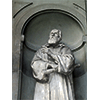
During the first half of the 19th century, 28 marble statues commemorating illustrious Tuscans were placed in the niches in the pillars of the Uffizi loggia. The sculptural cycle portrays the fathers and defenders of the homeland, the fathers of the arts of drawing as well as poets, politicians, historians and men of science.
The series of scientists opens with the statue of Galileo Galilei, sculpted by Aristodemo Costoli in 1851 and placed on the shorter side of the Uffizi. The Pisan scientist is shown holding a telescope, the emblematic instrument of the revolution in astronomy, with which he inaugurated the era of telescopic astronomy. Starting from 1609, Galileo observed for the first time the mountains and valleys of the Moon, the curious figure of Saturn, the phases of Venus, the stars that made up the Milky Way, sunspots and the satellites of Jupiter, which he dedicated to the Medici family, calling them "Medicean stars". These discoveries constituted significant proofs in favour of the Copernican system.
Another scientist portrayed in the loggia is Francesco Redi from Arezzo (P. Costa, 1854). A member of the Accademia del Cimento and the Accademia della Crusca, personal physician to the Medici Grand Dukes, naturalist and man of letters, Redi effectively represents the figure of the seventeenth-century court scientist and intellectual. Through a world-famous experiment, he showed the belief in the spontaneous generation of insects to be false.
Among the other scientists portrayed are the famous sixteenth-century botanist Andrea Cesalpino (P. Fedi, 1854), Pier Antonio Micheli (V. Consani, 1856), considered the founder of mycology, the anatomist Paolo Mascagni (L. Caselli, 1852) and Leonardo da Vinci (L. Pampaloni, 1842).
(Graziano Magrini)
Nel vicino Istituto e Museo di Storia della Scienza una delle sale è interamente dedicata a Galileo e contiene numerosi strumenti di sua invenzione, tra cui il giovilabio, il termoscopio, il compasso e il piano inclinato. Vi è conservato anche il dito medio della sua mano destra prelevato al momento della traslazione della salma.
Founded in 1927 under the name of Institute and Museum of the History of Science by initiative of the University of Florence, it had a decisive role in the realisation of the First National Exposition of the History of Science (Florence, 1929). The first exhibition halls were opened to the public in 1930 in the venue of Palazzo Castellani adjoining the Uffizi Gallery, which it still occupies today. After undergoing major renovations since 2007, the Institute reopened in 2010 under the new name of Museo Galileo.
The scientific instruments collections of the museum are among the most important in the world. These collections are an eloquent testimony of the promotion of scientific research conducted first by the exponents of the Medici dynasty, and then by the Lorraine Grand Dukes. Starting from Cosimo I, the Medici Grand Dukes started collecting instruments of extraordinary beauty and innovative conception. The Medici scientific collection was initially conserved in the Sala delle Carte in Palazzo Vecchio. Later, it was placed in the Stanzino delle Matematiche and in the adjoining Sala delle Matematiche in the Uffizi Gallery. Continually increasing in size, these collections remained in the Gallery, alongside masterpieces of the figurative arts and the most unique natural wonders, until the mid 18th century when the scientific collections were separated from the art collections.
Transferred to the Museum of Physics and Natural History, founded by Grand Duke Peter Leopold in 1775, the Medici scientific collections were enriched by substantial acquisitions of new instruments and experimental apparatuses. Under its first director, Felice Fontana, the Museum of Physics became an important structure for studies and diffusion of scientific culture. On the occasion of the Third Congress of Italian Scientists in 1841, the Galileo Tribune was built at the Museum of Physics and Natural History, to accommodate the most important instruments of the Medici collection, alongside those invented and utilised by Galileo and the Accademia del Cimento.
In 1860, as a consequence of the Unification of Italy, the Museum of Physics and Natural History was suppressed. Most of the collections were assigned to the Facoltà dell'Istituto di Studi Superiori [Faculties of the Institute of Advanced Studies]. Only the antique instruments and the zoology and anatomy collections remained in their original location. In 1925, the University of Florence was founded, becoming owner of the old scientific collections. In 1927, in order to guarantee their preservation and valorisation, the Institute and Museum of the History of Science was founded, and received the Medici-Lorraine collections of scientific instruments at its venue in Palazzo Castellani. Thanks to the commitment of its first directors, Andrea Corsini and Maria Luisa Righini Bonelli, the Museum of the History of Science of Florence progressively transformed into a centre of conservation, dissemination and research of recognised international importance.
In the course of the past years, the museum layouts have been entirely reconceived; the library has become the Italian centre of reference for studies of the history of science and technology, and of scientific museology. The Institute has organised international conferences and seminars, training courses, and exhibitions destined to prestigious itinerancies. It has also published a large number of volumes of studies and dissemination. Didactic activity has also greatly developed at the same time, accompanied by the realisation of innovative multimedia products distributed both on the Internet and off line.
The current exhibit, whose premises and contents have been radically renovated, develops over two floors of Palazzo Castellani. The exhibition itinerary is articulated along chronological and thematic criteria. The first floor is dedicated to the instruments of the Medici collections, exhibited in nine rooms where visitors can observe, among other things, refined mathematical instruments, Galileo's original instruments (including the only two telescopes of those personally built by the Pisan scientist that have come down to us), the glass instruments of the Accademia del Cimento, and the extraordinary collection of terrestrial and celestial globes, dominated by the monumental armillary sphere by Antonio Santucci. The nine rooms on the upper floor present the scientific testimonies of the Lorraine age. They illustrate the outstanding Tuscan and Italian contribution to the development of electricity, electromagnetism and chemistry, the complex works of both portable and tower clocks, the extraordinary series of obstetrical waxes, the chemistry cabinet of Grand Duke Peter Leopold and, finally, the beautiful and didactically effective machines to demonstrate the fundamental principles of physics, built by the workshop of the Museum of Physics and Natural History.
The restoration of the interior of the Palazzo Castellani (which dates from the twelfth century) has emphasized its monumental dimension and architectural distinction. The elegant, state-of-the-art display cases highlight the esthetic quality of the objects on view, while ensuring their perfect conservation. Portable interactive video-guides—used for the first time in a museum—make the most complex instruments fully understandable even to non-specialist visitors. The devices offer access to hypertext pages, 3D animations, and biographies. Visitors can use the video-guides to select an itinerary through the museum tailored to their specific interests.
(Graziano Magrini)
Florence’s National Library, which you come to after a half-kilometer walk along the Arno riverbank, possesses the largest collection of Galileo’s personal writings, part of a fund of more than 300 manuscripts that started out from an original nucleus thanks to the tenacity of Vincenzo Viviani, and thereafter grew with additions from the first and second generation of Galileo’s followers. A later addition was due to the passion of Antonio Favaro, the most important publisher of Galileo’s works.
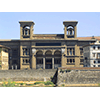
The Library originated from the book holding of Antonio Magliabechi, consisting of some 30,000 volumes and bequeathed to the city of Florence in 1714. In 1737, the grand-ducal administration established that the works published in Florence should be deposited there, and in 1743, the rule was extended to all works published in Tuscany. The Library opened to the public in 1747. In 1774, it was assigned part of the library of physician Antonio Cocchi. Considerable increments arrived following the suppression of church foundations. In 1861, it was united with the Palatine Library, formed by Grand Duke Ferdinand III of Lorraine. In 1885, it took the name of National Library and, in 1875, appellative of Central. In 1870, it was given printing rights on national territory. Originally housed in the Palazzo della Dogana, adjoining the Uffizi, the Library was transferred to its present, specially built headquarters in 1935. The 1966 flood caused serious damage: part of the holding was either lost or damaged. Following the event, the Centre for Book Restoration was instituted, and is still active today. The Library publishes the Bibliografia Nazionale Italiana, and is the pilot headquarters for the institution of the National Library Service.
Its manuscripts of scientific interest include the precious Galilean collection and the Targioni Tozzetti holding. The main nucleus of the Galilean collection, born of the obstinate commitment that Vincenzo Viviani put into conserving and recovering it, and later the property of Giovanni Battista Clemente de’ Nelli, was purchased by Ferdinand III in 1818. Further increased with other Galilean manuscripts from libraries, archives and private collections, it was first ordered by the Grand Duke himself. Reordered by Vincenzo Antinori, the Collection consisting of 348 volumes is divided into five sections: the first gathers documents that belonged to Vincenzo Galilei; the second comprises manuscripts by Galileo Galilei; the third section contains several documents by the scientist’s contemporaries; the fourth conserves codices by Benedetto Castelli, Bonaventura Cavalieri, Evangelista Torricelli and Vincenzo Viviani, while the fifth contains the papers that belonged to the Accademia del Cimento. An appendix follows, containing papers and documents of Galilean interest, donated to the library by Antonio Favaro, curator of the national edition of the works of Galileo Galilei.
The Targioni Tozzetti holding comprises manuscripts that at different times became part of the National Library patrimony. The first nucleus was purchased for the Palatine Library by Grand Duke Leopold II in 1851. The second nucleus, consisting of manuscripts by Giovanni, Ottaviano and Antonio Targioni Tozzetti, and the papers of Pier Antonio Micheli, including the Micheli-Targioni herbal, was sold to the National Library in 1894. The miscellanea of the Targioni library and the printed works of the Tozzettis’ were purchased by the Magliabechi Library in 1857. The entire collection comprises texts of botany, mineralogy, biology, geology, chemistry, agriculture and medicine, along with literary pamphlets, travelogues and autographs of illustrious personages.
The Library preserves eighteenth, nineteenth-century collections of dried plants from the manuscript holdings of the religious corporations suppressed between the 18th and 19th centuries. It also presents a pair of globes (celestial and terrestrial), made by Venetian cosmographer Vincenzo Coronelli in 1696 and dedicated to William III of Orange, King of England.
Emblems of science are also found outside of the Library. On one of the turrets of the facade (on the viewer’s right) is the statue of Galileo Galilei holding up his telescope. Also on the facade is a series of medallions dedicated to famous personages. Among them, Leonardo da Vinci and, again, Galileo.
(Anna Toscano)
On the other side of the Arno, on Via Romana, Galileo’s Tribune, at Palazzo Torrigiani, contains a set of frescoes painted in seven lunettes that display a chronology of the history of the scientific method starting with Galileo’s studies.
Built at the initiative of Grand Duke Leopoldo II of Lorraine and situated in Palazzo Torrigiani, the Tribune of Galileo was inaugurated in 1841 on the occasion of the Third Congress of Italian Scientists. The building, designed by the Florentine architect Giuseppe Martelli, was erected in honour of Galileo Galilei and was conceived as an iconographic synthesis of experimental science. It is a monument unique of its kind, a "Scientific sanctuary", as it was called by Vincenzo Antinori, at the time director of the Museum of Physics and Natural History. The work presents a rich iconographic display, with frescoes and bas-reliefs depicting instruments, scientific discoveries and the scientists who made them possible.
In particular, the seven lunettes display, with the rhetorical commemoration typical of the 19th century, the development of experimental science according to a precise, linear chronological sequence. Galileo, of course, is at the centre of the iconographic narration. The scene opens with Leonardo da Vinci in the presence of Ludovico Sforza, Duke of Milan. It continues, in the second lunette, with Galileo shown demonstrating the law of falling bodies; in the third we see the Pisan scientist intent on observing the lamp in the Cathedral of Pisa; in the fourth, as he presents his telescope to the Venetian Senate; in the fifth Galileo, by now elderly and blind, converses with his disciples; in the sixth, an experimental session of the Galilean Accademia del Cimento; and lastly, in the seventh, the logical conclusion: Alessandro Volta shown demonstrating to Napoleon the experiment of the Volta battery.
At the centre of the Tribune's hemicycle stands the statue of the great Pisan scientist sculpted by Aristodemo Costoli. At the sides are displayed some of the scientific instruments of Galileo and of the Accademia del Cimento, found today in the Florence Institute and Museum of the History of Science.
The vestibule of the Tribune is covered by a glass-and-cast-iron lantern (the glass has now been replaced with Plexiglas), which constitutes one of the first Florentine models of architecture with a metal structure and a fine example of synthesis between science, technology and the artistic iron-working industry.
(Graziano Magrini)
At a stone’s throw from Galileo’s home in Pian de’ Giullari, and about 8 km. from Palazzo Torrigiani, is the Torre del Gallo, long-time site of a small museum that gathered together Galileo’s papers and personal objects, by the initiative of its owner Paolo Galletti. The sale of the villa together with all its contents when Galletti died unfortunately caused the dispersion of various pieces from the collection, which however have been partially retrieved into the collections of the Institute and Museum of the History of Science.
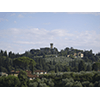
Located in the hills of Arcetri, near the Villa "Il Gioiello" where Galileo Galilei spent the last years of his life, the Torre del Gallo towards the end of the 19th century was a site dedicated to the memory of the illustrious Pisan scientist.
In 1872, after various dynastic transfers, the Tower was purchased by count Paolo Galletti who set up a little museum exhibiting memorabilia, busts and portrait of Galileo.
In 1902, the property was purchased by antiquarian Stefano Bardini who transformed the tower into a neo-Medieval castle. The project remained unfinished and the building was later abandoned. During World War II, the building was headquarters of the Military Pharmaceutical Institute, then of the Fascist Federation and, after being requisitioned by British troops, of a prison camp.
Various rehabilitation projects have been recently presented that would like to give the building a cultural and scientific use, with particular attention for astronomy.
(Graziano Magrini)
Besides its clearly advantageous observational position, the Astrophysics Observatory of Arcetri, inaugurated in 1872, was built on the hillside because of its symbolic proximity to the villa where Galileo spent the last years of his life and was confined after his sentencing in 1633.
In a report in 1751, director of the Observatory of Pisa, Tommaso Perelli, indicated the hill of Arcetri as the location best suited to site an observatory. His idea, however, remained simply an idea. It was only in the course of the following century that an observatory was built precisely at Arcetri and inaugurated on October 27, 1872. The transfer of astronomical research from the "Specola" on Via Romana, by then considered inadequate due to its unfortunate location, to the hill of Arcetri was favoured and organised by astronomer Giovanni Battista Donati. The site has an evident symbolic significance, as it is tied to the memory of Galileo Galilei who precisely at Arcetri, in the villa "Il gioiello" spent the last years of his life.
The new Observatory was under the authority of the Institute of Advanced Studies. At the end of the 19th century, the observatory was renovated and its equipment was improved. Antonio Abetti, appointed director, attended to completely restoring the instruments. In 1920, his son Giorgio was appointed to teach Astrophysics. In 1924, the Officine Galileo built a Solar Tower, inaugurated the following year, which made it possible to carry out advanced studies in solar physics. In 1954, Observatory management was taken over by Guglielmo Righini, under whom solar radio astronomy was born at Arcetri. The first radio telescope was installed in 1956. In the past decades, research at Arcetri has continued on levels of excellence in the various sectors of astronomy and astrophysics, also utilising astronomical structures situated abroad and managed by the Florentine observatory.
This historical collection of astronomical apparatuses includes, among the various instruments, telescopes (the one by Giovan Battista Amici is quite important), pendulum clocks and astronomical lenses. Most of the ancient texts and archive documents have been entrusted to storage at the Institute and Museum of the History of Science.
The Observatory has a study room equipped with projection systems, a machine to visualise cosmic rays, calculators, a spectroscope, a planetary system in scale, and celestial maps. It also manages the planetarium of the city of Florence in collaboration with the Science and Technology Foundation and the Institute and Museum of the History of Science.
(Graziano Magrini)
****************************
Texts by Sara Bonechi
English translation by Edward Tosques
Last update 17/ott/2008



 = libraries and archives
= libraries and archives  = scientific research centers
= scientific research centers  = memorial places of scientists
= memorial places of scientists = public health places
= public health places = places of science and worship
= places of science and worship = places of technology
= places of technology  = museums and collections
= museums and collections  = villas and gardens of science
= villas and gardens of science





